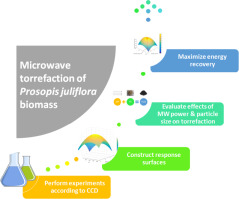当前位置:
X-MOL 学术
›
Fuel Process. Technol.
›
论文详情
Our official English website, www.x-mol.net, welcomes your feedback! (Note: you will need to create a separate account there.)
Microwave torrefaction of Prosopis juliflora : Experimental and modeling study
Fuel Processing Technology ( IF 7.5 ) Pub Date : 2018-04-01 , DOI: 10.1016/j.fuproc.2017.12.007 Pradeep Natarajan , Dadi V. Suriapparao , R. Vinu
Fuel Processing Technology ( IF 7.5 ) Pub Date : 2018-04-01 , DOI: 10.1016/j.fuproc.2017.12.007 Pradeep Natarajan , Dadi V. Suriapparao , R. Vinu

|
Abstract This study is focused on evaluating the effect of particle size and microwave power on torrefaction of the invasive biomass species, Prosopis juliflora (PJF), via experiments and theoretical model. Experiments were conducted using a central composite design (CCD) approach to construct response surfaces capturing the effects of these two factors on three key characteristics of the obtained char, viz. yield, calorific value and energy recovery. Highest char yield was obtained at an intermediate microwave power for a given particle size, while the calorific value increased with both the parameters. The response surface for energy recovery was convex with maxima at 481 W power for 1.9 mm particles. A microwave-based thermogravimetric study was conducted to obtain the mass loss profile during torrefaction. Assuming a global, single-step, power-law kinetic model with Arrhenius-type rate constant for torrefaction, the apparent activation energy and reaction order were estimated to be 173.93 kJ mol − 1 and 1.3, respectively. To explain the trends of char yields, a new approach was proposed that integrates the temperature profile information with the inferred kinetic model. Two parameters, viz. torrefaction time and average temperature, are introduced to quantify the temperature profiles during torrefaction. The generic model can be extended to any biomass species and reactor configuration by conducting suitable experiments. Detailed composition analysis of the bio-oil revealed that, unlike conventional torrefaction, significant degradation of lignin also occurred along with hemicellulose degradation at low bulk temperatures during microwave torrefaction.
中文翻译:

紫花莲子的微波烘焙:实验和模型研究
摘要 本研究的重点是通过实验和理论模型评估粒径和微波功率对入侵生物物种 Prosopis juliflora (PJF) 烘焙的影响。实验使用中心复合设计 (CCD) 方法来构建响应面,以捕捉这两个因素对获得的炭的三个关键特征的影响,即。产量、热值和能量回收。对于给定的颗粒尺寸,在中等微波功率下获得最高的焦炭产率,而热值随着这两个参数而增加。对于 1.9 mm 颗粒,能量回收的响应面是凸面,最大功率为 481 W。进行了基于微波的热重研究以获得烘焙过程中的质量损失曲线。假设一个全局的,单步的,根据具有 Arrhenius 型烘焙速率常数的幂律动力学模型,表观活化能和反应级数分别估计为 173.93 kJ mol - 1 和 1.3。为了解释焦炭产率的趋势,提出了一种新方法,将温度分布信息与推断的动力学模型相结合。两个参数,即。烘焙时间和平均温度被引入来量化烘焙过程中的温度曲线。通过进行适当的实验,通用模型可以扩展到任何生物质种类和反应器配置。生物油的详细成分分析表明,与传统烘焙不同,在微波烘焙过程中,在低体积温度下,木质素的显着降解和半纤维素降解也发生了。
更新日期:2018-04-01
中文翻译:

紫花莲子的微波烘焙:实验和模型研究
摘要 本研究的重点是通过实验和理论模型评估粒径和微波功率对入侵生物物种 Prosopis juliflora (PJF) 烘焙的影响。实验使用中心复合设计 (CCD) 方法来构建响应面,以捕捉这两个因素对获得的炭的三个关键特征的影响,即。产量、热值和能量回收。对于给定的颗粒尺寸,在中等微波功率下获得最高的焦炭产率,而热值随着这两个参数而增加。对于 1.9 mm 颗粒,能量回收的响应面是凸面,最大功率为 481 W。进行了基于微波的热重研究以获得烘焙过程中的质量损失曲线。假设一个全局的,单步的,根据具有 Arrhenius 型烘焙速率常数的幂律动力学模型,表观活化能和反应级数分别估计为 173.93 kJ mol - 1 和 1.3。为了解释焦炭产率的趋势,提出了一种新方法,将温度分布信息与推断的动力学模型相结合。两个参数,即。烘焙时间和平均温度被引入来量化烘焙过程中的温度曲线。通过进行适当的实验,通用模型可以扩展到任何生物质种类和反应器配置。生物油的详细成分分析表明,与传统烘焙不同,在微波烘焙过程中,在低体积温度下,木质素的显着降解和半纤维素降解也发生了。



























 京公网安备 11010802027423号
京公网安备 11010802027423号